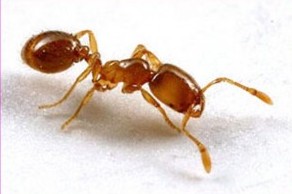

One of the most common bug infestations in the United States comes from one of the smallest culprits, tiny ants. These micro sized marauders, Solenopsis Molesta, also known as thief ants, get their name from their instinct of nesting close to other ant colonies, from which they steal food. Colloquially referred to as grease ants because they are attracted to the fatty proteins in grease and oils, S. Molesta range anywhere from 1/32 of an inch (0.5 mm) to 1/8 of an inch (3 mm) long. Typically spanning across varying yellowish grey or brownish tones of color, these ants have a two-segmented petiole connecting their abdomen to the thorax. Although hard to see with the naked eye, they have 10 segments in their antennae, which end in large segmented clubs. As they are so small, the amount of sting to their bite is disproportionate and is potent enough to cause a slight pain sensation. Thief ants have small stingers on their oblong abdomen, and generally have small eyes. Worker ants have large jaws for carrying food back to the colony.
Commonly found in the central states and the east coast, the habitat of this type of ant is vast, because they can survive just about anywhere. They can live in people’s homes, in the cracks or under the floorboards of homes, building nests anywhere. In their natural environment they are found in places such as under rocks, in exposed soil and within rotting logs. If they cannot find any of these things, then they move into another colony. Their nests are generally large for the ants’ size, and have tunnels that lead to another ant colony for a reliable and steady food source.
These guys eat grease whenever they find it, which is why they are sometimes called grease ants. They also eat meat, cheese and other dairy products, and seeds. They also eat larvae and pupae of other ant species. Thief ants do not appear to be attracted to sweets, unlike most other ants. They will however, consume fruits and sugary soft drinks. Be sure to clean areas with a surface cleaner and not leave items such as butter or drippings left sitting on the counter or stove.
The most effective way to control a grease ant infestation is to contact a local pest management professional here at Sunstate Pest Management. Your technician will provide an inspection to determine where the nest is located, plus provide the most effective and efficient prevention and control service and recommendations.
